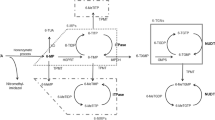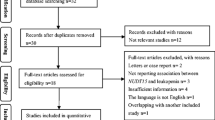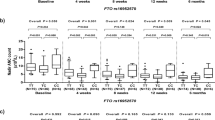Abstract
Background and Aims
Polymorphisms in the nucleotide diphosphate-linked moiety X-type motif 15 (NUDT15) gene are associated with thiopurine-induced leukopenia in patients with inflammatory bowel disease (IBD). NUDT15-associated subcellular thiopurine metabolism has not been investigated in primary lymphocytes. We hypothesized that NUDT15 mutation increases DNA-incorporated deoxythioguanosine (dTG) and induces apoptosis in lymphocytes.
Methods
DNA-incorporated dTG in peripheral blood mononuclear cells (PBMCs) and 6-thioguanine nucleotides (6-TGN) in red blood cells were measured in patients with IBD undergoing thiopurine treatment. The association of a single nucleotide polymorphism for NUDT15 (rs116855232) with dTGPBMC was examined. The pro-apoptotic effect of DNA-incorporated dTG was examined ex vivo in association with NUDT15 genotypes by co-culturing patient-derived peripheral CD4+ T lymphocytes with 6-thioguanine (6-TG).
Results
dTGPBMC was significantly higher in NUDT15 variants than in non-variants. dTGPBMC, but not 6-TGNRBC, negatively correlated with peripheral lymphocyte counts (r = – 0.31 and – 0.12, p = 0.012 and 0.173, respectively). DNA-incorporated dTG significantly accumulated to a greater extent in lymphocytes from NUDT15 variants when co-cultured with 6-TG ex vivo than in those from non-variants and was associated with decreased proliferation and increased apoptosis.
Conclusion
Increased DNA-incorporated dTG may be responsible for thiopurine-induced leukocytopenia through cell apoptosis in IBD patients with NUDT15 mutation.



Similar content being viewed by others
Data availability
The data underlying this article will be shared on reasonable request to the corresponding author.
Abbreviations
- CD:
-
Crohn’s disease
- FBS:
-
Fetal bovine serum
- HBSS:
-
Hanks’ balanced salt solution
- IBD:
-
Inflammatory bowel disease
- PBMC:
-
Peripheral blood mononuclear cell
- PBS:
-
Phosphate buffered saline
- RBC:
-
Red blood cell
- SNP:
-
Single nucleotide polymorphism
- UC:
-
Ulcerative colitis
- WBC:
-
White blood cell
- WST:
-
Water-soluble tetrazolium
References
Kobayashi T, Siegmund B, Le Berre C, et al. Ulcerative colitis. Nat Rev Dis Primers. 2020;6:74.
Torres J, Mehandru S, Colombel JF, et al. Crohn’s disease. Lancet. 2017;389:1741–55.
Timmer A, Patton PH, Chande N, et al. Azathioprine and 6-mercaptopurine for maintenance of remission in ulcerative colitis. Cochrane Database Syst Rev 2016:CD000478.
Chande N, Patton PH, Tsoulis DJ, et al. Azathioprine or 6-mercaptopurine for maintenance of remission in Crohn's disease. Cochrane Database Syst Rev 2015:CD000067.
Derijks LJ, Gilissen LP, Hooymans PM, et al. Review article: thiopurines in inflammatory bowel disease. Aliment Pharmacol Ther. 2006;24:715–29.
Tiede I, Fritz G, Strand S, et al. CD28-dependent Rac1 activation is the molecular target of azathioprine in primary human CD4+ T lymphocytes. J Clin Invest. 2003;111:1133–45.
Neurath MF. Current and emerging therapeutic targets for IBD. Nat Rev Gastroenterol Hepatol. 2017;14:269–78.
Thul PJ, Akesson L, Wiking M, et al. A subcellular map of the human proteome. Science 2017;356.
Valerie NC, Hagenkort A, Page BD, et al. NUDT15 Hydrolyzes 6-Thio-DeoxyGTP to Mediate the Anticancer Efficacy of 6-Thioguanine. Cancer Res. 2016;76:5501–11.
Moriyama T, Nishii R, Perez-Andreu V, et al. NUDT15 polymorphisms alter thiopurine metabolism and hematopoietic toxicity. Nat Genet. 2016;48:367–73.
Yang SK, Hong M, Baek J, et al. A common missense variant in NUDT15 confers susceptibility to thiopurine-induced leukopenia. Nat Genet. 2014;46:1017–20.
Kakuta Y, Kawai Y, Okamoto D, et al. NUDT15 codon 139 is the best pharmacogenetic marker for predicting thiopurine-induced severe adverse events in Japanese patients with inflammatory bowel disease: a multicenter study. J Gastroenterol 2018.
Hibi T, Naganuma M, Kitahora T, et al. Low-dose azathioprine is effective and safe for maintenance of remission in patients with ulcerative colitis. J Gastroenterol. 2003;38:740–6.
Komiyama T, Yajima T, Kubota R, et al. Lower doses of 6-mercaptopurine/azathioprine bring enough clinical efficacy and therapeutic concentration of erythrocyte 6-mercaptopurine metabolite in Japanese IBD patients. J Crohns Colitis. 2008;2:315–21.
Chang JY, Park SJ, Jung ES, et al. Genotype-based Treatment With Thiopurine Reduces Incidence of Myelosuppression in Patients With Inflammatory Bowel Diseases. Clin Gastroenterol Hepatol 2020;18:2010–2018 e2.
Kopylov U, Battat R, Benmassaoud A, et al. Hematologic indices as surrogate markers for monitoring thiopurine therapy in IBD. Dig Dis Sci. 2015;60:478–84.
Cuffari C, Hunt S, Bayless TM. Enhanced bioavailability of azathioprine compared to 6-mercaptopurine therapy in inflammatory bowel disease: correlation with treatment efficacy. Aliment Pharmacol Ther. 2000;14:1009–14.
Kamada N, Hisamatsu T, Okamoto S, et al. Unique CD14 intestinal macrophages contribute to the pathogenesis of Crohn disease via IL-23/IFN-gamma axis. J Clin Invest. 2008;118:2269–80.
Coulthard SA, Berry P, McGarrity S, et al. Liquid chromatography-mass spectrometry for measuring deoxythioguanosine in DNA from thiopurine-treated patients. J Chromatogr B Analyt Technol Biomed Life Sci. 2016;1028:175–80.
Dervieux T, Meyer G, Barham R, et al. Liquid chromatography-tandem mass spectrometry analysis of erythrocyte thiopurine nucleotides and effect of thiopurine methyltransferase gene variants on these metabolites in patients receiving azathioprine/6-mercaptopurine therapy. Clin Chem. 2005;51:2074–84.
Lek M, Karczewski KJ, Minikel EV, et al. Analysis of protein-coding genetic variation in 60,706 humans. Nature. 2016;536:285–91.
Moriyama T, Yang YL, Nishii R, et al. Novel variants in NUDT15 and thiopurine intolerance in children with acute lymphoblastic leukemia from diverse ancestry. Blood. 2017;130:1209–12.
Walker GJ, Harrison JW, Heap GA, et al. Association of genetic variants in NUDT15 with thiopurine-induced myelosuppression in patients with inflammatory bowel disease. JAMA. 2019;321:773–85.
Cuffari C, Seidman EG, Latour S, et al. Quantitation of 6-thioguanine in peripheral blood leukocyte DNA in Crohn’s disease patients on maintenance 6-mercaptopurine therapy. Can J Physiol Pharmacol. 1996;74:580–5.
Moreau AC, Paul S, Del Tedesco E, et al. Association between 6-thioguanine nucleotides levels and clinical remission in inflammatory disease: a meta-analysis. Inflamm Bowel Dis. 2014;20:464–71.
Nielsen OH, Coskun M, Steenholdt C, et al. The role and advances of immunomodulator therapy for inflammatory bowel disease. Expert Rev Gastroenterol Hepatol. 2015;9:177–89.
Heerasing NM, Ng JF, Dowling D. Does lymphopenia or macrocytosis reflect 6-thioguanine levels in patients with inflammatory bowel disease treated with azathioprine or 6-mercaptopurine? Intern Med J. 2016;46:465–9.
Asada A, Nishida A, Shioya M, et al. NUDT15 R139C-related thiopurine leukocytopenia is mediated by 6-thioguanine nucleotide-independent mechanism in Japanese patients with inflammatory bowel disease. J Gastroenterol. 2016;51:22–9.
Zhu X, Wang XD, Chao K, et al. NUDT15 polymorphisms are better than thiopurine S-methyltransferase as predictor of risk for thiopurine-induced leukopenia in Chinese patients with Crohn’s disease. Aliment Pharmacol Ther. 2016;44:967–75.
Marinkovic G, Hamers AA, de Vries CJ, et al. 6-Mercaptopurine reduces macrophage activation and gut epithelium proliferation through inhibition of GTPase Rac1. Inflamm Bowel Dis. 2014;20:1487–95.
Acknowledgements
We would like to extend our sincere gratitude and appreciation to Tadae Mori (Department of Gastroenterology, Kitasato University Kitasato Institute Hospital), Yuki Watanabe, Toyomi Ishibashi (Center for Advanced IBD Research and Treatment, Kitasato University Kitasato Institute Hospital) for helping us to collect clinical samples and data.
Funding
This work was supported in Japan by a grant from the Japan Foundation for Applied Enzymology, Japan Society for the Promotion of Science KAKENHI Grant Number JP19K17443, and a Grant-in-Aid for the Intractable Disease Project of the Ministry of Health, Labour and Welfare of Japan. In the UK, measurement of dTG incorporation was supported by Newcastle Healthcare Charity, the JGW Patterson Foundation, and a Confidence in Concept award from the Medical Research Council.
Author information
Authors and Affiliations
Contributions
TK devised the conceptual ideas of the study. TT, TK, SK, AU, HK, SO, OT, CPFR, HT, RO, SS, MN, SAC, YT, and TH all made substantial contributions to all of the following: design of the study, acquisition of data, analysis and interpretation of data, revising the article critically for important intellectual content, and final approval of the version to be submitted. TT and TK also contributed to drafting the article. All authors had full access to all the data in the study and had final responsibility for the decision to submit for publication.
Corresponding author
Ethics declarations
Conflicts of interest
T. Toyonaga receives research grants from Pfizer Inc. T. Kobayashi receives lecture fees from Abbvie Inc, Kyorin Pharmaceutical, Mitsubishi Tanabe, EA Pharma, Medtronic Co., Ltd, Janssen, Mochida Pharmaceutical, Takeda Pharmaceutical, Gilead Sciences, Nippon Kayaku, JIMRO, ZERIA Pharmaceutical, Astellas, Asahi Kasei Medical, Thermo Fisher Scientific, and Pfizer, advisory/consulting board fees from Abbvie Inc, Alfresa Pharma, Celltrion, Pfizer, Eli Lilly, Ferring Pharmaceuticals, Covidien, Janssen, Mochida Pharmaceutical, Takeda Pharmaceutical, Gilead Sciences, Nippon Kayaku, ZERIA Pharmaceutical, Thermo Fisher Scientific, and EA Pharma, and grants from EA Pharma, Thermo Fisher Scientific, Alfresa Pharma, and Nippon Kayaku. T. Hibi receives lecture fees from Mitsubishi-Tanabe Pharma, Kyorin Pharmaceutical, Abbvie GK, Janssen, JIMRO Co., Ltd, EA Pharma, Mochida Pharmaceutical, Takeda Pharmaceutical, Gilead Sciences, Celltrion, Nippon Kayaku, Kissei Pharmaceutical, Miyarisan Pharmaceutical, Zeria Pharmaceutical, and Ferring Pharmaceutical, advisory/consulting board fees from Abbvie GK,Takeda Pharmaceutical, Mitsubishi-Tanabe Pharma, JIMRO Co., Ltd, EA Pharma, Eli Lilly, Pfizer Japan Inc, Nichi-Iko Pharmaceutical, and Nippon Kayaku, and research grants from EA Pharma, Abbvie GK, JIMRO Co., Ltd, Zeria Pharmaceutical, Otsuka Pharmaceutical Co., Ltd. M. Nakano receives lecture/consultant fees from Covidien, Mochida Pharmaceutical, Takeda Pharmaceutical, Zeria Pharmaceutical, Kyorin Pharmaceutical and Nippon Kayaku, and research fundings from Mitsubishi Tanabe Pharma and Japanese foundation for research and promotion of endoscopy. S. Sagami has served as a speaker for AbbVie, Takeda Pharmaceutical, Zeria Pharmaceutical, served as a consultant for Nippon Kayaku, and an endowed chair from AbbVie, EA Pharma, JIMRO, Kyorin Pharmaceutical, Mochida Pharmaceutical, and Zeria Pharmaceutical, and has received research funding from Japan Foundation for Applied Enzymology.
Additional information
Publisher's Note
Springer Nature remains neutral with regard to jurisdictional claims in published maps and institutional affiliations.
Supplementary Information
Below is the link to the electronic supplementary material.
Rights and permissions
About this article
Cite this article
Toyonaga, T., Kobayashi, T., Kuronuma, S. et al. Increased DNA-incorporated thiopurine metabolite as a possible mechanism for leukocytopenia through cell apoptosis in inflammatory bowel disease patients with NUDT15 mutation. J Gastroenterol 56, 999–1007 (2021). https://doi.org/10.1007/s00535-021-01820-0
Received:
Accepted:
Published:
Issue Date:
DOI: https://doi.org/10.1007/s00535-021-01820-0




